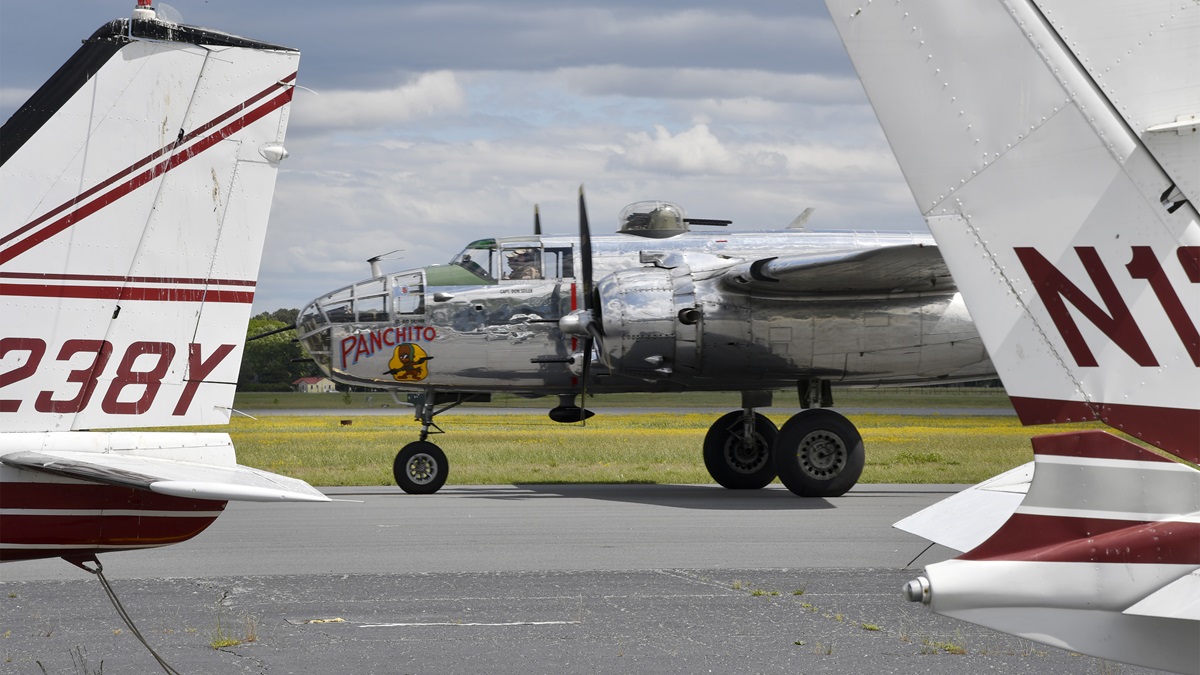Early US Air Force vet returns to B-25 after six decades
With the nimbleness more akin to a 24-year-old than an 84-year-old, Sid Ellner maneuvered his way from the North American B-25 Mitchell's jumpseat to the left seat, taking the controls of the lumbering bomber for the first time in 61 years.
“You made an old man very happy today,” Ellner said with a smile after his orientation flight in Panchito, an airplane the veteran likely flew when he was undergoing multiengine training at Vance Air Force Base in Enid, Oklahoma, in the 1950s. Peacock, an expert on the B-25J’s history, said the airplane was based there at that time.
“It was a real pleasure for me. I’ve always had this on my bucket list,” Ellner said. “My mind was telling me I think I could take the thing off and land it. When I saw what Cal was doing here with the flight school, I had to give it a try.”
Ellner reunited with the bomber in early May at its home base at Delaware Coastal Airport in Georgetown, Delaware, having flown his Cessna 172RG in from White Plains, New York, where he is based. “Sitting there toward the end, I started to feel comfortable. A lot of it came back to me,” he said of the B-25 flight.
Ellner read about the Delaware Aviation Museum Foundation’s program offering flight training in Panchito in the form of type ratings, second-in-command type ratings, and orientation flights. He called Peacock, who is the director of training, and set the wheels in motion, wanting one more chance to fly his favorite airplane.
“Of all the airplanes that I’ve flown that was really the best,” he said, gesturing to the gleaming twin-engine bomber. “My favorite airplane. I have great memories.”
In ROTC while in college at the University of Connecticut, Ellner chose the Air Force in 1955, entering the service as part of Class 55-Q. “We were the very first class to go through as officers,” Ellner related. Previously, cadets went through flight training. Officers didn’t always adjust well to the flight-training regimen, he said, noting it took the Air Force a couple of years to figure out how to handle officers as pilots in training.
Ellner’s training started in a J-3 Cub at Bartow Air Base in Bartow, Florida, but he then quickly graduated to the T-6, with its 600-horsepower engine. “We thought that was the cat’s pajamas,” he said. His bomber track led him to the B-25 and ultimately to the B-36, where on a few occasions he flew live nuclear weapons. One mission had them flying nonstop from Spokane to Guam, 35 hours without refueling. “That gives you a sense of the range of that airplane,” he said.
Ellner left the military in 1957, but didn’t leave flying or his friendships behind. Reminded of Memorial Day, he reflected on what his time in the service meant. “I think more of my friends and fellow classmates who aren’t here anymore. There’s something about flying relationships that you end up with friends for a lifetime. It’s a very unusual kind of relationship.”
Spry, sharp, and always ready with a funny quip, joke, or punch line, Ellner impressed Peacock, who has flown many veterans in Panchito. “Sid is a rather remarkable individual. Very, very sharp,” said Peacock. “He nailed” the flight. “There are not many military-trained B-25 pilots left who are still an active pilot.”
After leaving the military, Ellner quickly discovered the need for an airplane for his 150- to 200-mile business trips. He bought a Cessna 210 with a partner and owned it for decades, only recently trading down to the Cessna 172RG. “My kids grew up in the 210,” he said, with it frequently used as a family hauler for vacations. These days, you’re likely to find him flying with the White Plains Breakfast Club, a group of pilots who meet every Saturday and Sunday morning looking for a place to fly to “the cheapest breakfast.”
The B-25 revisit will undoubtedly be fodder for those breakfast meetings. “A hole in one is nothing compared to this,” Ellner said. “Having flown it 200 hours in the military—loving that airplane—and then having the opportunity some 60 years later to get in it and actually be at the controls was just a great experience.”
“That’s what makes it special,” said Panchito owner Larry Kelley. “Those late nights when you have hydraulic fluid dripping out of your ears—seeing Sid fly that airplane today, reliving that part of his youth, makes it all worthwhile.”
















